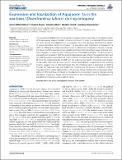Expression and localization of Aquaporin 1a in the sea-bass (Dicentrarchus labrax) during ontogeny
View/
Date
12/07/2011Grant ID
NE/C513234/1
NE/E015514/1
NE/F001401/1
Metadata
Show full item recordAbstract
The successful establishment of a species in a given habitat depends on the ability of each of its developing stages to adapt to the environment. In order to understand this process we have studied the adaptation of a euryhaline fish, the sea-bass Dicentrarchus labrax, to various salinities during its ontogeny. The expression and localization of Aquaporin 1a (AQP1a) mRNA and protein were determined in different osmoregulatory tissues. In larvae, the sites of AQP1a expression are variable and they shift according to age, implying functional changes. In juveniles after metamorphosis (D32–D48 post-hatch, 15–25mm) and in pre-adults, an increase in AQP1a transcript abundance was noted in the digestive tract, and the AQP1a location was observed in the intestine. In juveniles (D87–D100 post-hatch, 38–48 mm), the transcript levels of AQP1a in the digestive tract and in the kidney were higher in sea water (SW) than at lower salinity. These observations, in agreement with existing models, suggest that in SW-acclimated fish, the imbibed water is absorbed via AQP1a through the digestive tract, particularly the intestine and the rectum. In addition, AQP1a may play a role in water reabsorption in the kidney. These mechanisms compensate dehydration in SW, and they contribute to the adaptation of juveniles to salinity changes during sea-lagoon migrations. These results contribute to the interpretation of the adaptation of populations to habitats where salinity varies.
Citation
Giffard-Mena , I , Boulo , V , Abed , C , Cramb , G & Charmantier , G 2011 , ' Expression and localization of Aquaporin 1a in the sea-bass (Dicentrarchus labrax) during ontogeny ' , Frontiers in Physiology , vol. 2 , 00034 . https://doi.org/10.3389/fphys.2011.00034
Publication
Frontiers in Physiology
Status
Peer reviewed
ISSN
1664-042XType
Journal article
Rights
Copyright © 2011 Giffard-Mena, Boulo, Abed, Cramb and Charmantier. This is an open-access article subject to a nonexclusive license between the authors and Frontiers Media SA, which permits use, distribution and reproduction in other forums, provided the original authors and source are credited and other Frontiers conditions are complied with.
Collections
Items in the St Andrews Research Repository are protected by copyright, with all rights reserved, unless otherwise indicated.

